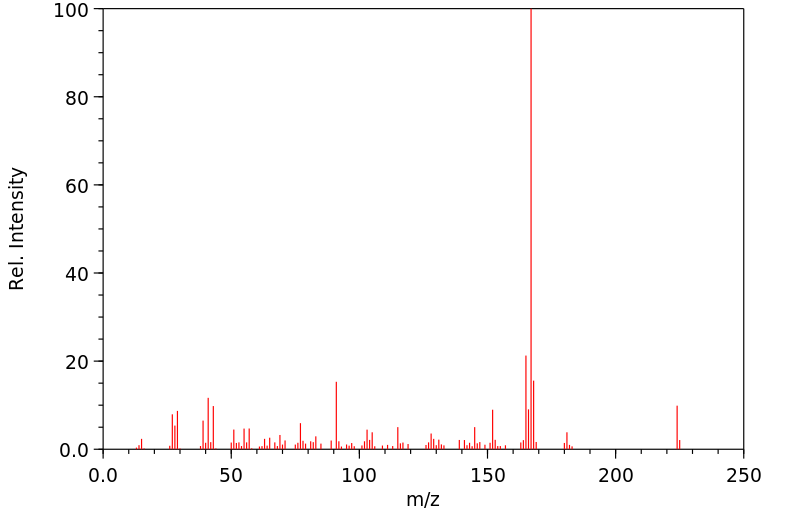(3-methylbutane-1,1-diyl)dibenzene | 26466-27-3
中文名称
——
中文别名
——
英文名称
(3-methylbutane-1,1-diyl)dibenzene
英文别名
Butane, 3-methyl-1,1-diphenyl-;(3-methyl-1-phenylbutyl)benzene
CAS
26466-27-3
化学式
C17H20
mdl
——
分子量
224.346
InChiKey
VLMDOKCOURAQDR-UHFFFAOYSA-N
BEILSTEIN
——
EINECS
——
-
物化性质
-
计算性质
-
ADMET
-
安全信息
-
SDS
-
制备方法与用途
-
上下游信息
-
文献信息
-
表征谱图
-
同类化合物
-
相关功能分类
-
相关结构分类
物化性质
-
沸点:297 °C
-
密度:0.9641 g/cm3(Temp: 21 °C)
计算性质
-
辛醇/水分配系数(LogP):5.5
-
重原子数:17
-
可旋转键数:4
-
环数:2.0
-
sp3杂化的碳原子比例:0.29
-
拓扑面积:0
-
氢给体数:0
-
氢受体数:0
反应信息
-
作为反应物:描述:参考文献:名称:Schaarschmidt; Hermann; Szemzoe, Chemische Berichte, 1925, vol. 58, p. 1916摘要:DOI:
-
作为产物:描述:1,1'-(3-methyl-1,2-butadienylidene)bisbenzene 在 palladium on activated charcoal 氢气 作用下, 以 乙酸乙酯 为溶剂, 生成 (3-methylbutane-1,1-diyl)dibenzene参考文献:名称:Wittig,G.; Haag,A., Chemische Berichte, 1963, vol. 96, p. 1535 - 1543摘要:DOI:
文献信息
-
Electrophotocatalytic diamination of vicinal C–H bonds作者:Tao Shen、Tristan H. LambertDOI:10.1126/science.abf2798日期:2021.2.5carbon-hydrogen (C–H) bonds to carbon–nitrogen (C–N) bonds is a highly valued transformation. Existing strategies typically accomplish such reactions at only a single C–H site because the first derivatization diminishes the reactivity of surrounding C–H bonds. Here, we show that alkylated arenes can undergo vicinal C–H diamination reactions to form 1,2-diamine derivatives through an electrophotocatalytic strategy
-
Substituted Hantzsch Esters as Versatile Radical Reservoirs in Photoredox Reactions作者:Fangjun Gu、Wenhao Huang、Xu Liu、Wenxin Chen、Xu ChengDOI:10.1002/adsc.201701348日期:2018.3.1Substituted Hantzsch esters can act as radical reservoirs in photoredox reactions, steadily releasing a carbon radical and a hydrogen atom radical in the absence of an additional electron acceptor. We propose that radical release by substituted Hantzsch esters occurs via a mechanism involving an internal redox cycle. Cinnamidecinnamides, styrenes, α,β‐unsaturated acids, and diarylethenes could be alkylated
-
Direct and Unified Access to Carbon Radicals from Aliphatic Alcohols by Cost‐Efficient Titanium‐Mediated Homolytic C−OH Bond Cleavage作者:Takuya Suga、Yuuki Takahashi、Chinatsu Miki、Yutaka UkajiDOI:10.1002/anie.202112533日期:2022.3combination of “TiCl2(cat)” and Zn (cat=catecholate) facilitates the homolytic cleavage of “non-activated” alcohol C−O bonds. All aliphatic primary, secondary and tertiary alcohols serve as good substrates. This method was applied to radical conjugate addition reactions successfully, and mechanistic studies indicate that alkyl chlorides are not intermediates. The active species is a 1 : 2 complex of alkoxide
-
Photocatalytic Hydroalkylation of Aryl-Alkenes作者:Cornelia S. Buettner、Michael Schnürch、Katharina Bica-SchröderDOI:10.1021/acs.joc.2c01304日期:2022.8.19aryl-alkenes affording C–C bonds using aryl-alkenes and alkyl iodides. We demonstrate the formation of various hydroalkylation products in excellent yields, with primary, secondary, and tertiary alkyl iodides being tolerated in the reaction. Mechanistic experiments reveal a pathway consisting of halogen atom transfer followed by a radical-polar crossover mechanism delivering the desired hydroalkylation products
-
Direct conversion of carboxylic acids to free thiols <i>via</i> radical relay acridine photocatalysis enabled by N–O bond cleavage作者:Dmitry L. Lipilin、Mikhail O. Zubkov、Mikhail D. Kosobokov、Alexander D. DilmanDOI:10.1039/d3sc05513b日期:——basic chemical compounds with diverse utility and widespread reactivity. However, the direct conversion of unprotected acids to thiols is hampered due to a fundamental problem – free thiols are incompatible with the alkyl radicals formed on decarboxylation of carboxylic acids. Herein, we describe a concept for the direct photocatalytic thiolation of unprotected acids allowing unprotected thiols and their
表征谱图
-
氢谱1HNMR
-
质谱MS
-
碳谱13CNMR
-
红外IR
-
拉曼Raman
-
峰位数据
-
峰位匹配
-
表征信息
同类化合物
(βS)-β-氨基-4-(4-羟基苯氧基)-3,5-二碘苯甲丙醇
(S,S)-邻甲苯基-DIPAMP
(S)-(-)-7'-〔4(S)-(苄基)恶唑-2-基]-7-二(3,5-二-叔丁基苯基)膦基-2,2',3,3'-四氢-1,1-螺二氢茚
(S)-盐酸沙丁胺醇
(S)-3-(叔丁基)-4-(2,6-二甲氧基苯基)-2,3-二氢苯并[d][1,3]氧磷杂环戊二烯
(S)-2,2'-双[双(3,5-三氟甲基苯基)膦基]-4,4',6,6'-四甲氧基联苯
(S)-1-[3,5-双(三氟甲基)苯基]-3-[1-(二甲基氨基)-3-甲基丁烷-2-基]硫脲
(R)富马酸托特罗定
(R)-(-)-盐酸尼古地平
(R)-(-)-4,12-双(二苯基膦基)[2.2]对环芳烷(1,5环辛二烯)铑(I)四氟硼酸盐
(R)-(+)-7-双(3,5-二叔丁基苯基)膦基7''-[((6-甲基吡啶-2-基甲基)氨基]-2,2'',3,3''-四氢-1,1''-螺双茚满
(R)-(+)-7-双(3,5-二叔丁基苯基)膦基7''-[(4-叔丁基吡啶-2-基甲基)氨基]-2,2'',3,3''-四氢-1,1''-螺双茚满
(R)-(+)-7-双(3,5-二叔丁基苯基)膦基7''-[(3-甲基吡啶-2-基甲基)氨基]-2,2'',3,3''-四氢-1,1''-螺双茚满
(R)-(+)-4,7-双(3,5-二-叔丁基苯基)膦基-7“-[(吡啶-2-基甲基)氨基]-2,2”,3,3'-四氢1,1'-螺二茚满
(R)-3-(叔丁基)-4-(2,6-二苯氧基苯基)-2,3-二氢苯并[d][1,3]氧杂磷杂环戊烯
(R)-2-[((二苯基膦基)甲基]吡咯烷
(R)-1-[3,5-双(三氟甲基)苯基]-3-[1-(二甲基氨基)-3-甲基丁烷-2-基]硫脲
(N-(4-甲氧基苯基)-N-甲基-3-(1-哌啶基)丙-2-烯酰胺)
(5-溴-2-羟基苯基)-4-氯苯甲酮
(5-溴-2-氯苯基)(4-羟基苯基)甲酮
(5-氧代-3-苯基-2,5-二氢-1,2,3,4-oxatriazol-3-鎓)
(4S,5R)-4-甲基-5-苯基-1,2,3-氧代噻唑烷-2,2-二氧化物-3-羧酸叔丁酯
(4S,4''S)-2,2''-亚环戊基双[4,5-二氢-4-(苯甲基)恶唑]
(4-溴苯基)-[2-氟-4-[6-[甲基(丙-2-烯基)氨基]己氧基]苯基]甲酮
(4-丁氧基苯甲基)三苯基溴化磷
(3aR,8aR)-(-)-4,4,8,8-四(3,5-二甲基苯基)四氢-2,2-二甲基-6-苯基-1,3-二氧戊环[4,5-e]二恶唑磷
(3aR,6aS)-5-氧代六氢环戊基[c]吡咯-2(1H)-羧酸酯
(2Z)-3-[[(4-氯苯基)氨基]-2-氰基丙烯酸乙酯
(2S,3S,5S)-5-(叔丁氧基甲酰氨基)-2-(N-5-噻唑基-甲氧羰基)氨基-1,6-二苯基-3-羟基己烷
(2S,2''S,3S,3''S)-3,3''-二叔丁基-4,4''-双(2,6-二甲氧基苯基)-2,2'',3,3''-四氢-2,2''-联苯并[d][1,3]氧杂磷杂戊环
(2S)-(-)-2-{[[[[3,5-双(氟代甲基)苯基]氨基]硫代甲基]氨基}-N-(二苯基甲基)-N,3,3-三甲基丁酰胺
(2S)-2-[[[[[((1S,2S)-2-氨基环己基]氨基]硫代甲基]氨基]-N-(二苯甲基)-N,3,3-三甲基丁酰胺
(2S)-2-[[[[[[((1R,2R)-2-氨基环己基]氨基]硫代甲基]氨基]-N-(二苯甲基)-N,3,3-三甲基丁酰胺
(2-硝基苯基)磷酸三酰胺
(2,6-二氯苯基)乙酰氯
(2,3-二甲氧基-5-甲基苯基)硼酸
(1S,2S,3S,5S)-5-叠氮基-3-(苯基甲氧基)-2-[(苯基甲氧基)甲基]环戊醇
(1S,2S,3R,5R)-2-(苄氧基)甲基-6-氧杂双环[3.1.0]己-3-醇
(1-(4-氟苯基)环丙基)甲胺盐酸盐
(1-(3-溴苯基)环丁基)甲胺盐酸盐
(1-(2-氯苯基)环丁基)甲胺盐酸盐
(1-(2-氟苯基)环丙基)甲胺盐酸盐
(1-(2,6-二氟苯基)环丙基)甲胺盐酸盐
(-)-去甲基西布曲明
龙蒿油
龙胆酸钠
龙胆酸叔丁酯
龙胆酸
龙胆紫-d6
龙胆紫







